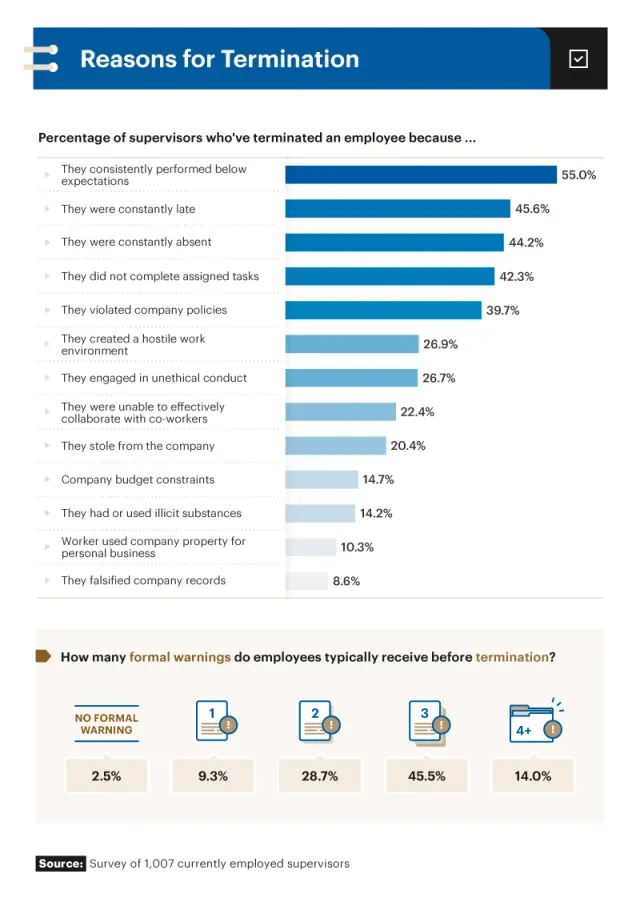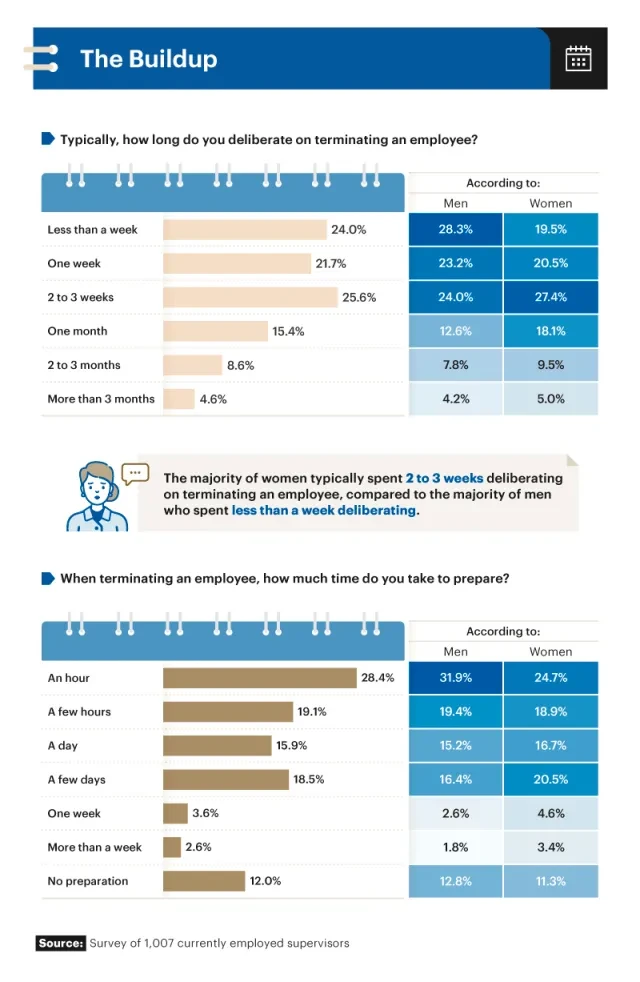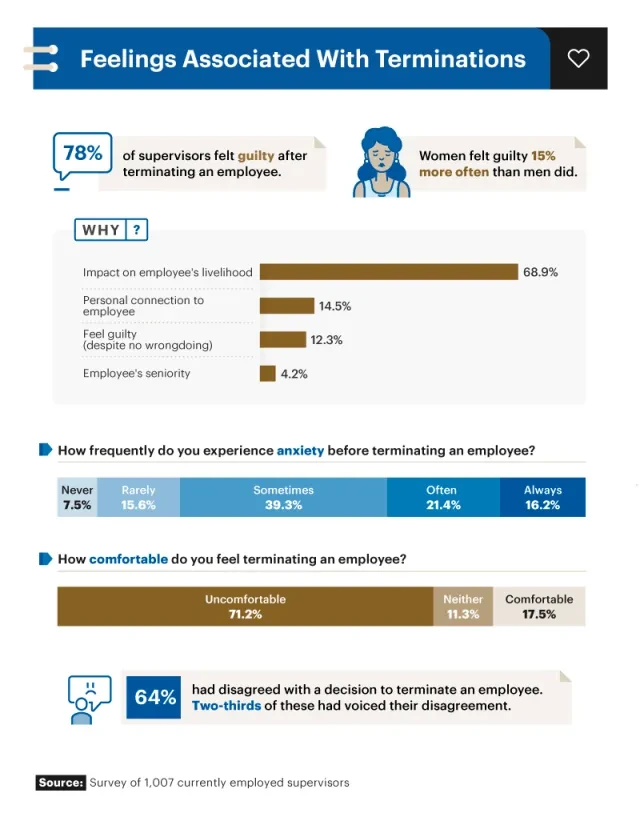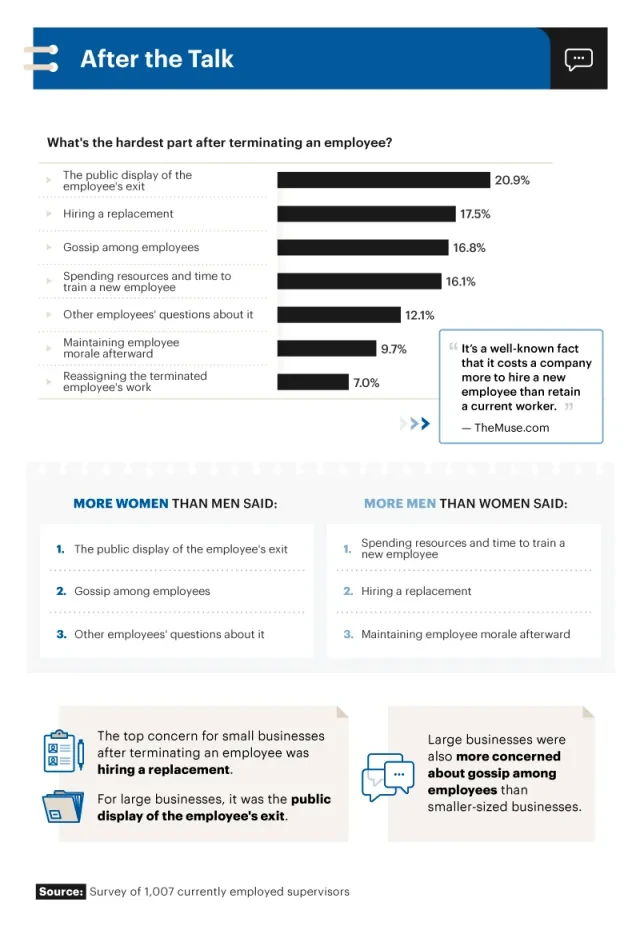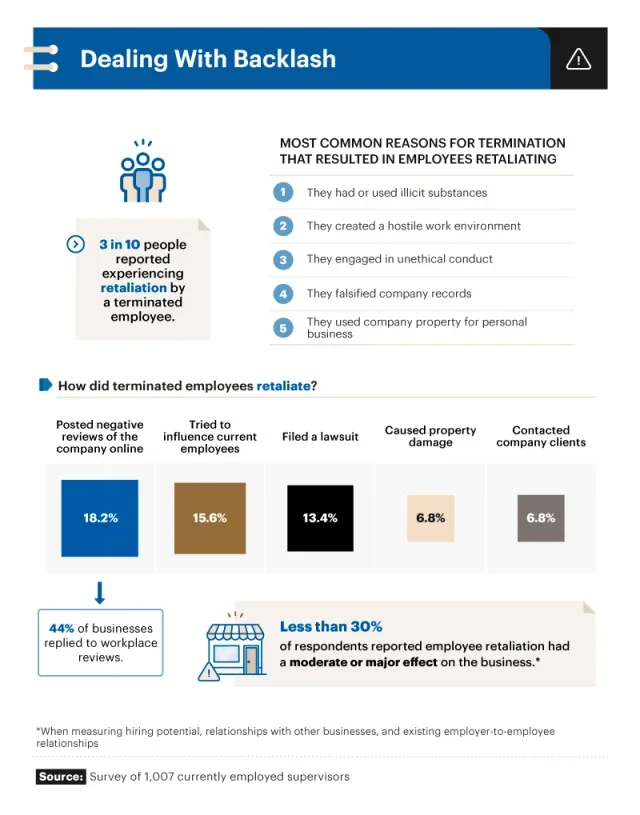No matter how much you like your job — or even how good you think you are at it — being terminated can be a traumatic surprise. Navigating what to do after being fired can involve processing feelings of grief, taking a hard, objective look at your performance, and drafting an actionable plan for the future.
As difficult as it is to deal with being terminated as an employee, it can be equally as stressful for supervisors, both on a professional and personal level. Managers and bosses dismissing their employees often feel anxiety, guilt, and discomfort with the process.
So, what is it really like to have to fire a member of your team? To find out, we surveyed over 1,000 supervisors with experience terminating employees for small, midsize, and large businesses. Read on as we explore the biggest reasons for firing someone, how long employers take before deciding to terminate someone, and the most difficult aspects of letting an employee go.
No other choice
While there are laws which prohibit termination based on protected classes or actions in the workplace, generally employees without an employment contract can be terminated at any time. Under employment-at-will, a company doesn't legally owe the employee an explanation when they are let for from the job.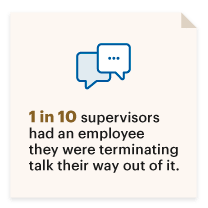
However, for more than half of supervisors, the biggest reason for terminating an employee was because they consistently performed below expectations. Being constantly late (almost 46%), absent (44%), or not completing assigned tasks (42%) were also common reasons for termination. Some analysts suggest employees with poor attendance can cost companies due to unplanned absences, not to mention negatively impact the productivity of colleagues.
Many employees receive some kind of formal warning or have been disciplined prior to termination. Just 2.5% of supervisors issued no formal warnings before terminating an employee. Instead, almost 46% of companies gave three formal warnings before firing someone, and 14% gave even more.
There may be instances when an employee can state a case for why their termination is unjust. One in 10 supervisors admitted to being talked out of firing an employee during the termination conversation.
Timeline of termination
For employers following proper protocols when firing a member of their staff, certain steps can protect both the emotional experience of the employee and the legal standing of the company. Among other things, this can include gathering documentation from previous conversations with the employee, carefully planning what to say, and first checking in with other members of the leadership team (including HR).
While roughly 1 in 4 supervisors deliberated for less than a week before terminating an employee, employers were more likely to take weeks to months before making a final decision. Nearly 22% of supervisors deliberated for a week before firing someone, and close to 26% of supervisors spent two to three weeks deciding if termination was the right course of action. A majority of women typically spent two to three weeks deliberating, while a majority of male supervisors deliberated for less than a week.
In preparation of terminating someone, 28% of supervisors spent an hour planning, although another 1 in 5 prepared for several hours, and nearly as many took a few days to get ready.
Emotional turbulence
Even when terminating an employee is clearly in the best interest of the company, it can still make supervisors feel guilty. In some cases, this may be a result of miscommunication or inconsistent firing practices in upper levels of the organization.
Seventy-eight percent of supervisors felt guilty after terminating an employee, including almost 70% of who said the employee’s livelihood was a cause of concern. More than 1 in 3 supervisors either often or always acknowledged feeling anxiety before letting someone go, and around 71% were uncomfortable with the termination process.
Negative repercussions
There’s a monetary cost associated with terminating an employee. In addition to separation benefits and hiring costs for the replacement, there are also indirect costs (including employee morale) that supervisors need to be aware of.
In the aftermath of letting someone go, 21% of supervisors said the hardest part was the public display of someone leaving. Like the loss of productivity when someone leaves the company (under any circumstances), terminating someone can negatively impact company culture.
Over 17% of supervisors identified the hiring process for a replacement as the hardest part of firing someone, followed by gossip among employees (nearly 17%), the cost of training someone new (16%), and questions asked by other employees (12%). Among women in charge of terminating staff members, the public display was more concerning, while men were preoccupied with the cost of training a new employee.
Lashing out
Firing an employee can be messy, so supervisors should follow proper termination protocols. 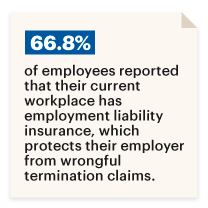
Three in 10 supervisors experienced some level of retaliation after terminating an employee, including over 18% who left negative reviews of the company online and 16% who tried to influence current employees. Among the biggest reasons for firing someone that led to retaliation were illicit substance possession or use, employees creating hostile work environments, and workers engaging in unethical conduct.
A major concern for employers letting someone go is wrongful termination lawsuits. Even if an employer maintains an at-will policy, federal, state, and local laws may prohibit termination based on several factors, including sex, gender, race, religion, disability, national origin, age, and pregnancy. Sixty-seven percent of supervisors reported working for companies with employment practices liability insurance, which helps protect their employer from wrongful termination claims.
A different perspective
Supervisors shared their insight into the termination process that employees may want to know.
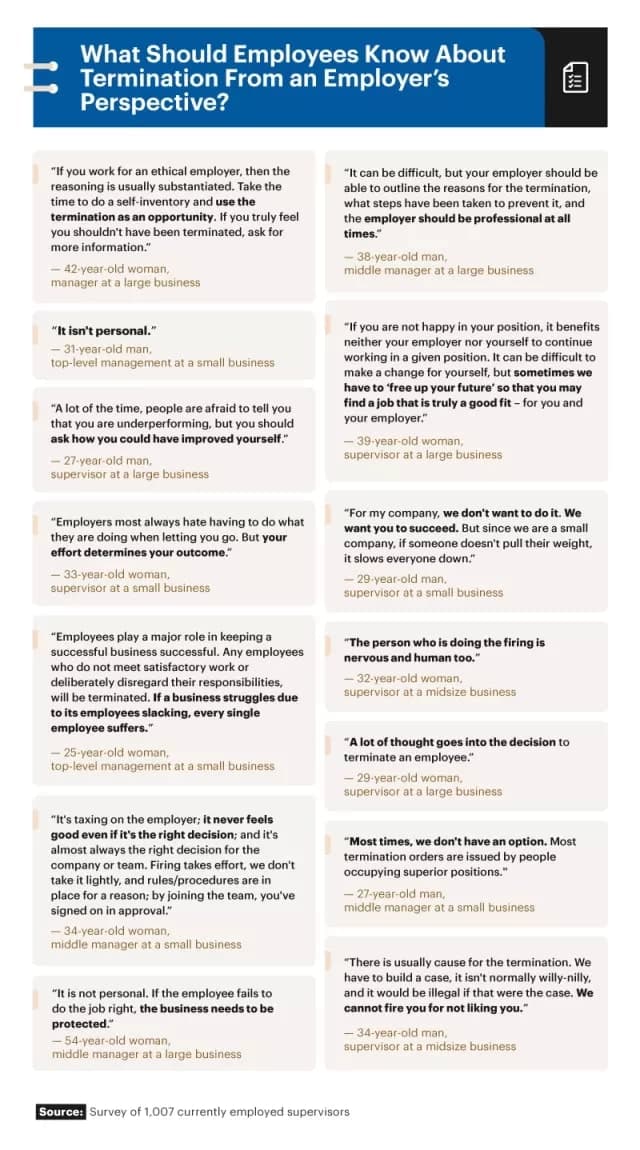
The most popular responses suggested it’s important not to take termination personally and to find ways to grow and learn from the experience. Not every job is right for every person, and a supervisor might provide an employee with information to help improve in their next position. Any ethical employer will always have documentation and reasoning behind their decision, and employees can ask for that before leaving.
Understanding both sides
Regardless of the circumstances, no one likes being let go from their job. The same could also be said for the people handling those terminations. Even if one person isn’t always responsible for firing an employee, the person delivering the news is very likely to feel guilty, anxious, and even uncomfortable throughout the process.
At Paychex, we’re committed to helping to foster productive employee-employer relationships every step of the way. From helping businesses streamline their hiring processes to helping ensure their employment practices are compliant with applicable laws, Paychex helps managers and supervisors focus on the tasks that need them the most. Visit us at Paychex.com to learn more.
Methodology and limitations
This project used survey data collected via Amazon’s Mechanical Turk platform. To participate, respondents needed to be currently employed part time or full time and have experience terminating employees. The distribution of participants is as follows:
- 49.9% were men, margin of error of 4% using 95% confidence interval testing.
- 50.1% were women, margin of error of 4% using 95% confidence interval testing.
- 37.7% of participants currently worked for a small business.
- 35.7% of participants currently worked for a midsize business.
- 26.5% of participants currently worked for a large business.
- Participants ranged in age from 19 to 87 with a mean of 38.5 and a standard deviation of 10.8.
For the graphic titled, “Feelings Associated With Terminations,” participants were asked to rate the level of guilt they felt after terminating an employee on a scale of 1 to 5, with 1 being “not at all guilty” and 5 being “very guilty.” Any response of 2 to 5 was grouped to calculate the percentage of participants who felt guilty overall.
The term “supervisor” has been used to identify all participants except in the graphic titled “What Should Employees Know About Firing From an Employer’s Perspective?”
This research is exploratory and aims to inspire future research on participants’ experiences during actual termination talks.
Sources
- How To Terminate an Employee, Paychex, 2025.
- I Feel Awful About Firing Someone, Inc., 2017.
- 8 Steps to Bouncing Back After Getting Fired, The Muse, 2020.
- 3 Lessons I Learned From Firing Someone, The Muse, 2020.
- How Employees With Poor Attendance Affect the Workplace, Chron - Small Business.
- How To Fire Someone in the Nicest Way Possible, Forbes, 2018.
- Understanding Title VII: Safeguard Your Company When Firing A Protected-Class Employee, Forbes, 2018.
Fair use statement
Want to help share what it’s like to be on the other side of an employee termination? You won’t get in trouble for sharing the results of our study for any noncommercial use; just remember to recognize our contributors by including a link back to this page in your story.









